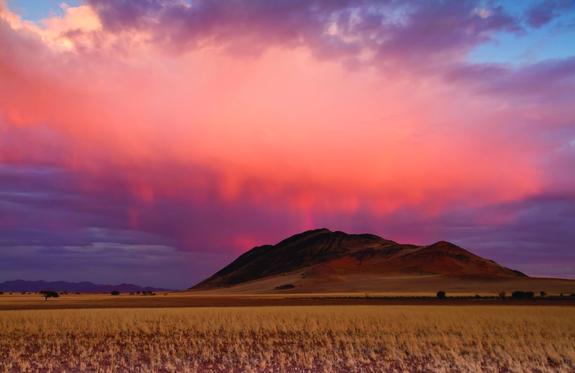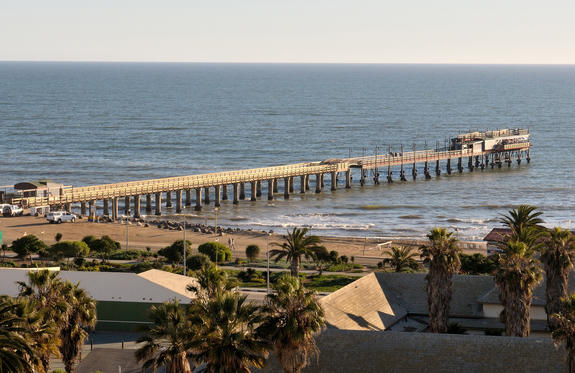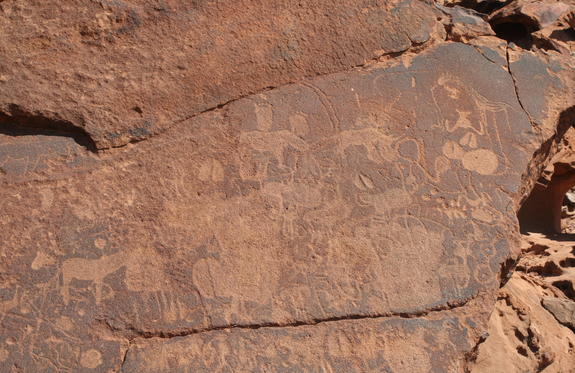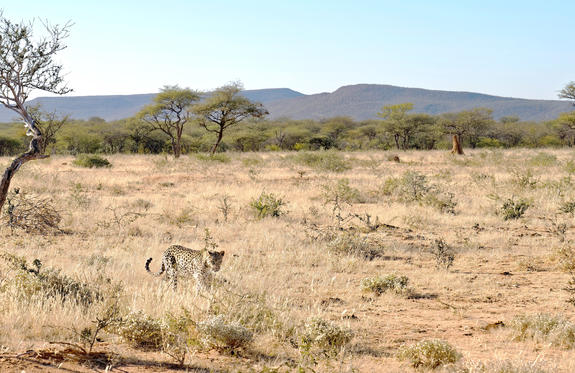Namibia, a timeless Adventure
“A land of contrast & dramatic beauty - exuding a timeless appeal. From awe-inspiring landscapes combined with untamed wildlife, it’s a boutique bucket list destination.”
In south western Africa lies a land of compelling fascination. A land for those who worship at the shrine of Africa at its most resplendent, but also at its most unconventional. This is Namibia.
Described by the bushman as the “Soul of the World”, Namibia is rugged, natural, soulful and liberating. While the forces of nature have been fierce and unforgiving, they have also been bountiful. In this cauldron of heat and relentless force, God has created landscapes that are paralleled in their beauty only by the most exquisite diamonds found here. Imagine huge canvasses, uninhibited by man’s limitations, splashing swathes of colour of the monumental, star shaped dunes of the Namib Desert and the surreal Salvador Dali’esque Deadvlei, with its white clay pans, red dunes and blue skies. The awe-inspiring mountain ranges of some of the last true wilderness areas in Damaraland and the forlorn, windswept skeleton coastline. As all Africa, Namibia has abundant wildlife in our National Parks as well as the large tracts of land which lie unfenced and unfettered for wildlife to traverse. Much of this land has been made available to the local communities, and both these, as well as private land of many farmers who have banded together, have been declared as local conservancies. Namibia also has the richest succulent flora in the world, harbouring about one-third of the world’s approximately 10,000 succulent species. Namibia is a melting pot of sights, sounds, aromas, tastes and emotions in abundance, just waiting to be experienced.
Namibia is home to the infamous Skeleton Coast, that forlorn and rugged coastline along the Atlantic Ocean. It is here where we find the Namib Desert, the World’s oldest desert and a World Heritage site, from which the country gets its name. The eastern expanses are dominated by the Kalahari Desert; the central highlands are renowned for its free-roaming wildlife and the Etosha National Park. Kaokoland and Damaraland are where we find some of the most dramatic landscapes, the uniquely adapted desert animals and the proud Ovahimba people. And to top it off – the contrast of the lush forest vegetation of the Zambezi region, part of the KAZA Transfrontier National Park. Like the diamonds mined here, Namibia is a true gemstone waiting to be discovered.
MAJOR ATTRACTIONS
Namibia’s appeal lies in its dramatic mix of spectacular landscapes, iconic cultures and African wildlife. The Namib Desert is home to the world’s highest dunes and oldest desert plant known to man. The Fish River Canyon is surpassed in size only by the Grand Canyon, while the 60 ton Hoba Meteorite is globally the largest of its kind. Namibia’s wildlife is exemplary and home to the Big 5, albeit, unlike a zoo, not found in one area. A great portion of Namibia falls under communal land, where the tourist can interact with age-old cultures such as the Himba, Damara and the Bushmen. Swakopmund, wedged between the Atlantic Ocean and the desert dunes and fondly known as Namibia’s playground, is a must for adventure and leisure tourists.
SEASONAL HIGHLIGHTS
Namibia is an all-year destination with over 300 days of sunshine. The dry winter months are generally better for game viewing and with clear cold skies, one of the world’s most sought after stargazing destinations. In wetter months, our green season, calving season commences and birding as well as botanical safaris are spectacular. The wide range of national parks ensure an unforgettable wildlife experience throughout the year.
ADVENTURE
Join expert rangers in Damaraland tracking desert elephant or black rhino, or experience the allure of the Namib Desert from a hot-air balloon. Hike the second largest canyon on earth, or learn first-hand survival practices from real Bushman while following them into the Kalahari. Watch dolphins and other aquatic animals on a catamaran cruise on the Atlantic Ocean or enjoy a roller coaster quad bike experience in the Namib Desert dunes.Enjoy your own self-drive adventure in national parks and untouched wilderness areas, meeting the cultures and relishing the freedom of endless space.
SHOPPING
All larger cities and towns offer high quality shopping and culinary experiences equal to European standards. While Windhoek’s high-end shopping malls are ideally suited to cater to all shopping needs, the centre of the city still offers streets where some smaller boutique style or owner managed outlets exist. Swakopmund has not yet acceded to the commercialism of malls and the town is still built around a small centre of busy shops. These more laid-back small arcades and cafeterias, all reachable on foot, promote a relaxed holiday atmosphere. Throughout Namibia guests can stop at informal markets en-route to their next destination to shop for wooden souvenirs, minerals, clothing or even traditional food.
DID YOU KNOW?
- Namibia has the highest concentration of Cheetahs on earth
- Namibia is the second least populated country
- 46% of Namibia’s surface area is under conservation management
- The entire coastline of Namibia is protected by national parks
- Etosha national park boasts 114 different animal species

The Kalahari is an exceptionally beautiful living desert a large semi-arid sandy savannah draped over a gently rolling inland sea of sand covering most of Botswana and large parts of Namibia and South Africa. It is also the last bastion of the San people with the modern world having enveloped all the other areas they once roamed. Here in Namibia it is typically red sands covered in thin, wispy, mostly golden grass and dotted with acacia trees and wide ranging wildlife including gemsbok, impala, jackals and cheetah.

The FishRiverCanyon is located in the northern part of the Nama Karoo. It is the second largest canyon on earth, featuring a gigantic ravine that measures in total about 100 miles (160 km) long, up to 27 km wide and in places almost 550 metres deep. The FishRiver is the longest interior river found in Namibia, but its flow at present is a trickle compared with the immense volume of water that poured down its length in ages past. It cuts deep into the plateau that is today dry, stony and sparsely covered with hardy drought resistant plants such as succulents, euphorbia’s and lonely quiver trees. The river flows intermittently, usually coming down in flood in late summer, and when it ceases to flow it becomes a chain of long narrow pools on the sandy rock-strewn floor of the chasm. At the lower end of the Fish River Canyon, the hot springs resort of Ai-Ais provides an oasis in the desolate rocky wastes. Guided and unguided walks into the canyon are possible during April to September, it is however strictly forbidden to climb into the canyon as a day visitor. In the canyon you may encounter several species of mammals, such as wild horses, Mountain Zebra (Hartman Zebra), Kudu, Klipspringer, Leopard, Steenbok, Baboon and Springbok. The most common rodents include mice, rats, dassies, and dassie-rats. Bird life includes surprises like Pelicans, Black Eagles, Fish Eagles, Kingfishers, Lovebirds, Wild Ostrich and various species of waterfowl and wading birds, like Herons. In the natural pools of the Fish River are found an abundance of fish, such as barbled catfish and yellow fish.

This region is typified by the Succulent Karoo. The distinctive climatic characteristics of the Succulent Karoo make it different from all other deserts in the world. Rainfall is reliable and predictable, falling mostly in winter, and prolonged droughts are rare. The Succulent Karoo’s botanical diversity is unparalleled by any other arid region on earth and is the world’s only plant hotspot that is entirely arid. This ecoregion is home to greater than 5,000 higher plant species, nearly 40 percent of which are endemic, and 18 percent of which are threatened. It has the richest succulent flora in the world, harbouring about one-third of the world’s approximately 10,000 succulent species. Other unique features include the diversity of miniature succulents (435 spp.) and geophytes (bulb-like plants 630 spp.). The ecoregion is also a center of diversity and endemism for reptiles and many invertebrate taxa, especially monkey beetles (Rutelinae: Hoplinii). The Namib Desert ecoregion to the north is characterized by extremely low and variable summer rain (less than 50 mm per year), and extremely sparse plant cover, dominated by ephemerals. To the east lies the Nama Karoo ecoregion, a low open shrubland with variable grass cover and highly variable rain that falls mainly in the late summer months.

The Namib is the world’s oldest desert, and although it stretches along the entire length of Namibia’s coastline, the Namib commonly refers to the vast sea of sand from Luderitz to Swakopmund. For a big sandy desert the scenery is remarkably varied, with the giant red dunes of Sossusvlei being the most famous part. Because of how old it is the Namib is home to numerous species that don’t occur elsewhere and although no humans live in the desert an amazing array of flora and fauna manages to survive here. Famous species include the Welwitschia – a living fossil plant, endemic chameleons, fur seals along the coast, brown hyenas, jackals and remarkably one of Africa’s largest antelope the Gemsbok. The name Namib is of Nama origin and means "vast place" and vast it certainly is.

With palm-lined streets, seaside promenades and fine accommodation for all budgets, Swakopmund is Namibia’s most popular holiday destination, and its pleasant summer climate and decent beaches attract surfers, anglers and beach lovers from all over Southern Africa. Thanks to its mild temperatures and negligible rainfall, Swakopmund generally enjoys grit in the oyster. When an easterly wind blows, the town gets a good sand-blasting, and almost perpetual drizzle. The fog rolls up to 30km inland and provides moisture for desert-dwelling plants and animals, including 80 species of lichen. For better or worse, Swakopmund feels overwhelmingly Teutonic – indeed, it has Germany – but for visitors, it’s a Namibia’s adrenalin capital, and offers a wide range of gut-curdling activities from sand boarding and quad-biking to skydiving and camel riding. Note, however, that it gets especially busy around Namibian school holidays in December and January, when temperatures average around 25ºC.

The small headland of Cape Cross lies on western Namibia’s Skeleton Coast, roughly 60 kilometres north of Henties Bay. The historic area was landed on by the Portuguese in 1486, and they erected a stone cross here in honour of the Portuguese King, however, this cross was replaced by the German settlers in the 1800’s. Cape Cross best known for its extraordinary breeding colony of Cape fur seals and has been made a reserve. With the abundance of fish swimming in the cold Benguela current, the seals have plenty to snack on, and they also enjoy lying and playing out in the sun. From a 200-metre-long walkway, visitors can watch the seals at play and learn about them through the area’s information points.

This National Heritage site confers yet another distinction to Namibia: that of one of the foremost centers of artwork in the world. It counts as the largest open-air art gallery in Southern Africa, its name reflecting a farmer’s incredulity that the unreliable spring (Afrikaans: Twyfelfontein) could have supported the Stone Age hunter and its prey for thousands of years. The reddish sandstone boulders seem to glow in the fierce heat, yet ancient man sheltered from enemy and spied on game from these surreal rock formations. Here he assiduously carved away at the intractable rock surfaces to imprint his indelible creations. Today, you can browse amongst these selfsame boulders and slabs of sandstone and marvel at the grandest spectacle of rock engravings in Africa. The area is also home to the geological phenomenum of Burnt Mountain and the Organ Pipes.

Resting majestically in the heart of Namibia's Damaraland region, The Grootberg Plateau showcases stunning natural landscapes characterised by deep canyons, dramatic rock formations, and expansive vistas. The renowned Grootberg Pass winds through mountains, offering spellbinding views. On the drive, one may come across the Himba people, known for centuries-old livestock farming practices. Encounters along the Grootberg Pass may include purchasing handmade jewellery while supporting the community with donations. Despite its rugged terrain, Grootberg hosts diverse wildlife, including black rhinos, giraffes, and desert elephants, adapted to harsh desert conditions. Additional activities include walking trails, birdwatching, and Damara Cultural Tours. End the day with a 4x4 drive atop the flat plains of the Grootberg Plateau that leads to a jaw-dropping viewpoint and watch the sunset.

Kaokoland is a compendium of the story of the earth, the product of a quintessential performance of nature not seen elsewhere. It has moulded a landscape of its own – strong, independent and inhospitable – for loneliness breeds individuality. It is one of the last remaining wilderness areas in Southern Africa. It is a world of incredible mountain scenery, a refuge for the rare desert dwelling elephant, black rhino and giraffe and the home of the Himba people. Although it is harsh and offers little respite at midday, the rugged landscape is especially attractive during the early morning and late afternoon when it is transformed into softly glowing pastel shades. The topography in the south of the area is characterised by rugged mountains which are dissected by numerous watercourses, but north of the Hoarusib River the scenery is dominated by table-top hills. Still further north, the OtjihipaMountains rise abruptly above the Namib floor to form the eastern boundary of the Marienfluss, while the west of the valley is defined by the HartmannMountains. The Marienfluss valley is very scenic and relatively greener than the Hartmann's valley. Hartmann's valley is closer to the Atlantic and yet much more arid. However, it does have a strange atmosphere when the sea mists drift inland.One of the most spectacular landmarks of the area is the Epupa falls. Several pools at the base of the waterfall allow for (relatively) crocodile free swimming.
Established as a missionary centre in the 1800s amidst the rugged landscapes of the Kaoko and Damara regions, Ondangwa is one of the oldest historic towns in the North Central Regions. It later became a key assembly point for people in the north seeking employment in southern towns, including South African mines, during the late 1950s and 1960s. Due to its central location, the town was used by the South African Army as an administrative centre until Namibia’s independence. Ondangwa’s vibrant markets are rich with traditional crafts, clothing, and local delicacies like dried caterpillars. Visitors can explore nearby Etosha National Park, renowned for its diverse wildlife and scenic salt pans. Outdoor enthusiasts will appreciate the hiking and biking trails that crisscross the area, providing a closer look at the region’s unique flora and fauna.

Situated on the eastern side of Etosha, bordering Fisher's Pan, Onguma Game Reserve is one of Namibia's best kept secrets! Here you will be afforded the opportunity of experiencing Africa in all her beauty and diversity. Onguma Game Reserve has more than 34,000 hectares of protected land and wildlife. Our nature reserve boasts over thirty different animal species consisting of plains game including kudu, giraffe, eland, oryx, hartebeest, zebra, impala and many more roam freely as well as predators such as lion, cheetah, leopard, being common residents of the area. The latest addition to the already abundant wildlife at Onguma Game Reserve is a family of black rhinos! More than 300 bird species can also be viewed at Onguma Game Reserve. During the Namibian summer months the nature reserve becomes a bird-watcher's paradise with thousands of species migrating to the wetlands created by the seasonal rains and ephemeral river systems.

The 96 kilometre fence surrounding the 22 000 ha Okonjima private, Nature Reserve was finally completed in 2010. This fence has created:
- a 20 000 ha reserve for Captive Carnivore rehabilitation (also home to Brown Hyaenas and the resident Leopards);
- a 2000 ha 'safe' area around Main Camp, Bush Camp, Bush Suite, the Omboroko Campsite and the PAWS Environmental Education Centre.
Although hunting is instinctive in carnivores, many of the cheetahs at AFRICAT lack experience due to being orphaned or removed from the wild at an early age. This inexperience, as well as their conditioning to captivity, makes them unsuitable for release. The 200km (20 000ha) NATURE RESERVE | PARK, provides captive cheetahs and other carnivores with the opportunity to hone their hunting skills and become self-sustaining and thereby giving them a chance to return to the wild. The captive cheetahs are fitted with radio-collars prior to their release into the reserve, so that their welfare and progress can be closely monitored.
Rehabilitation gives a captive carnivore a second chance to be released back into the wild and to take the time it needs, to become a completely independent hunter - in a protected area right in the middle of commercial farmland!



